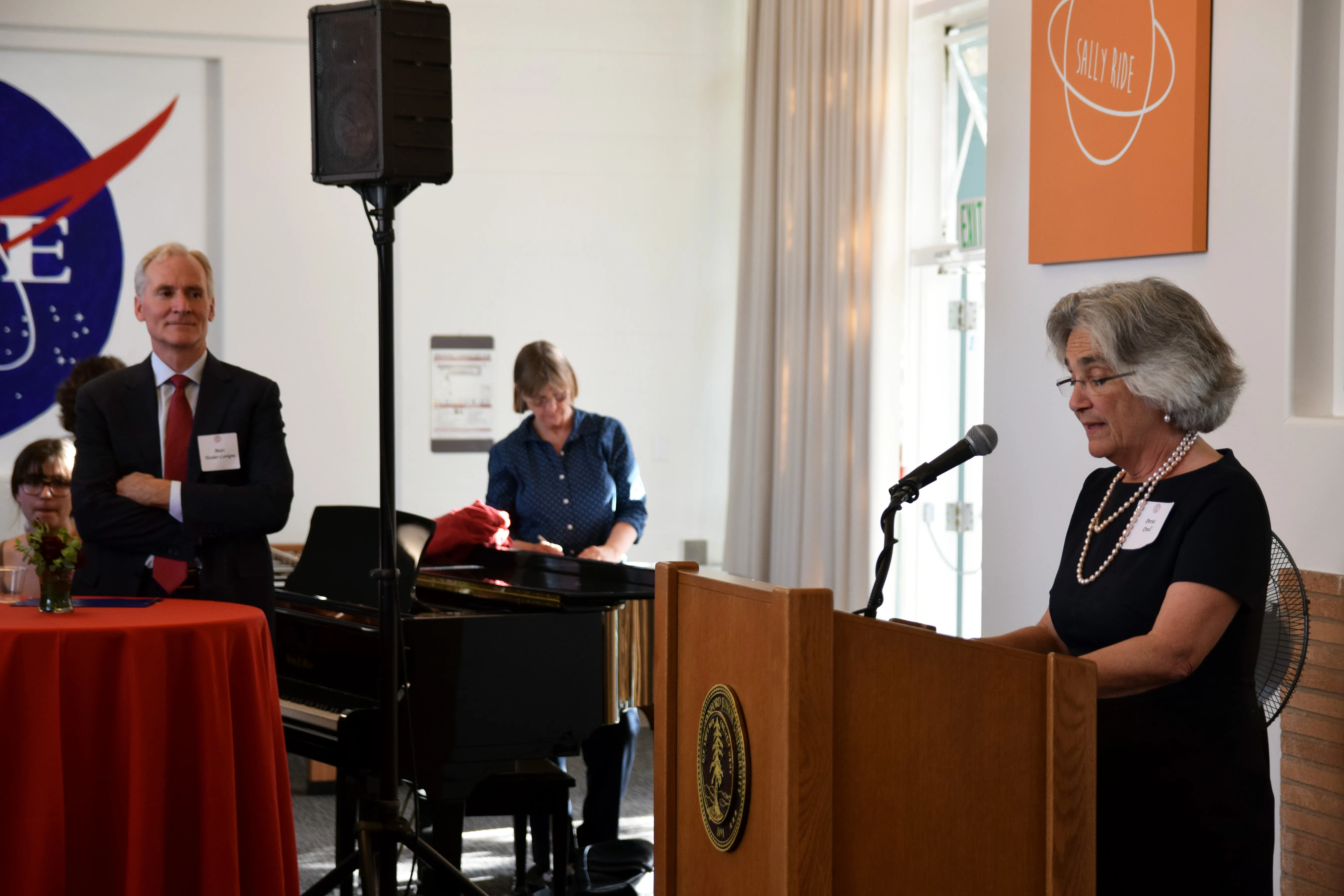Members of the Stanford community came together to celebrate the renaming of the Sally Ride in Stern Hall on Thursday evening. The residents of Sally Ride, recently renamed from Serra, welcomed University President Marc Tessier-Lavigne and Provost Persis Drell, members of the Stanford Native American community and Joyce and Bear Ride, the mother and sister of Sally Ride.
‘Around the world and beyond’
The ceremony began with opening remarks from Tessier-Lavigne, who acknowledged the land of the Muwekma Ohlone tribe, which Stanford occupies, and honored the contributions of the Native American community to Stanford. Tessier-Lavigne cited the event as a reaffirmation of Stanford’s values, particularly the “priority of inclusion.”
The president’s words were particularly meaningful as the renaming follows years of efforts by the Stanford Native American community to condemn Father Junipero Serra’s treatment of Native Americans and the historical erasure of indigenous voices on campus.
Such efforts led to the creation of the University Advisory Committee on Renaming Junipero Serra Features, which worked alongside numerous communities at Stanford to decide to rename Serra House in the Clayman Institute for Gender Research and Serra Mall along with the dorm in September 2018.
After years of controversy and deliberation regarding the renaming of buildings and features, the University announced on Feb. 28 that the Serra dorm would be renamed to honor Sally Ride ’78 while the Serra House would honor Carolyn Attneave M.A. ’47 Ph.D. ’52.
Ride, a physicist and astronaut, was a member of the 1983 Challenger mission, in which she became the first American woman in space. Ride also remains the youngest astronaut to have traveled to space. After leaving the National Aeronautics and Space Administration (NASA) in 1987, she worked at Stanford’s Center for International Security and Arms Control (CISAC), now called the Center for International Security and Cooperation.
Attneave was a psychologist of mixed Lenni-Lenape and Scandinavian heritage who played a significant role in creating the field of Native American mental health. She founded the Society of Indian Psychologists and North American Indian Center of Boston, focusing on cross-cultural heritage and psychology.
Michelle Reininger, Resident Fellow for Sally Ride dorm, reflected on the role of community within Sally Ride House. She saw the name change as an “embodiment of a community coming together to grapple with our past and walk toward our future.”
Reininger specifically thanked the members of the Native American community on campus, who initiated the process for the renaming, as well as the dorm community who came together to honor those who represent dimensions of diversity often overlooked. The name change “projects the best of Stanford’s ideals and values,” she said.
Inclusivity and identity
Sally Ride resident Ria Calcagno ’22, who advocated to name her dorm after Sally Ride in the renaming process, spoke about students’ excitement about the name change. Calcagno highlighted the ways in which Sally Ride’s legacy demonstrates the best aspects of the Stanford community — she not only achieved individual feats within her fields, but used her position to empower and uplift others as well.
Ride exemplified “lifting as you climb,” said Calcagno, emphasizing the necessity of both individual and collective strength in building a community. Calcagno highlighted the way in which the renaming has brought the dorm community together, resulting in increased community pride and a sense of shared identity.
The Sally Ride community also had the honor of welcoming Sally Ride’s mother’s mother and sister to the celebration. Both guests elaborated on Ride’s love of Stanford and her commitment to the education and empowerment of youth, especially in regard to education.
“She’d love it,” said Bear, Sally’s sister, describing what she thought Sally would think of the celebration of community.
The celebration ended with remarks from Stanford American Indian Organization co-chair Carson Smith ’19, who spoke on behalf of the Native American community of students at Stanford. Smith recognized the renaming as a first step in acknowledging the often forgotten and erased history of the Native community in California, emphasizing that there is still much work to be done.
Smith ended the celebration by presenting the dorm with a traditional Pendleton blanket, a gift from the Native American community. The blanket, embroidered with stars, is a significant piece of Native American art within many communities, traditionally presented at births and other important events.
Reininger commented on the hope that the renaming process and name itself represents for the creation of a more inclusive Stanford community, in which residents feel accepted and valued.
“There is a power and influence in the naming of place,” Reininger said. “Especially when that place is a home.”
Contact Brooke Beyer at bbeyer ‘at’ stanford.edu.
